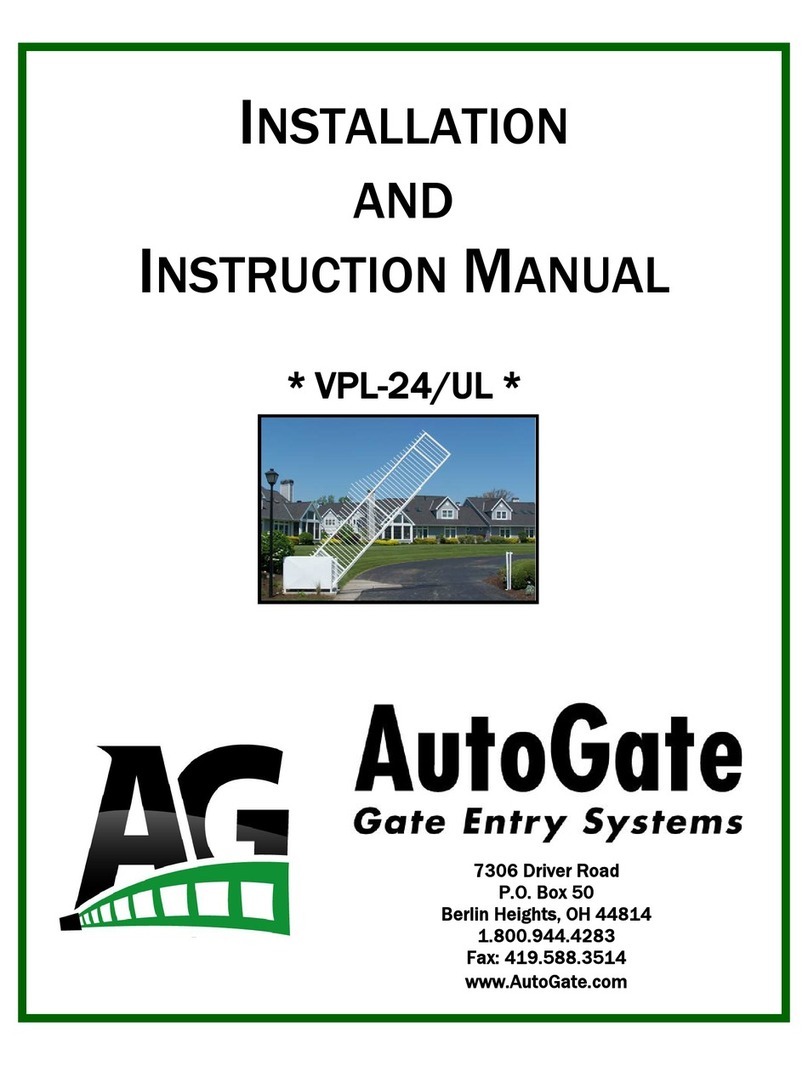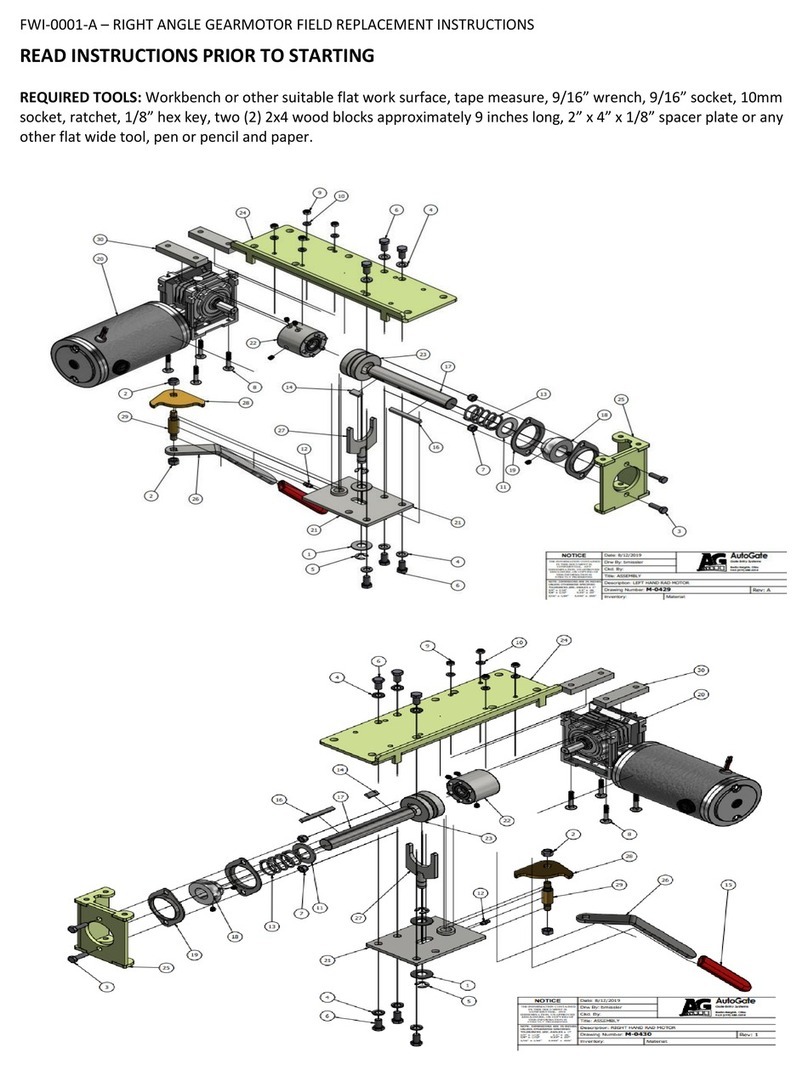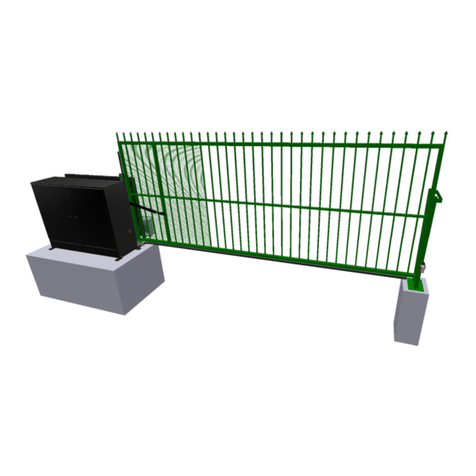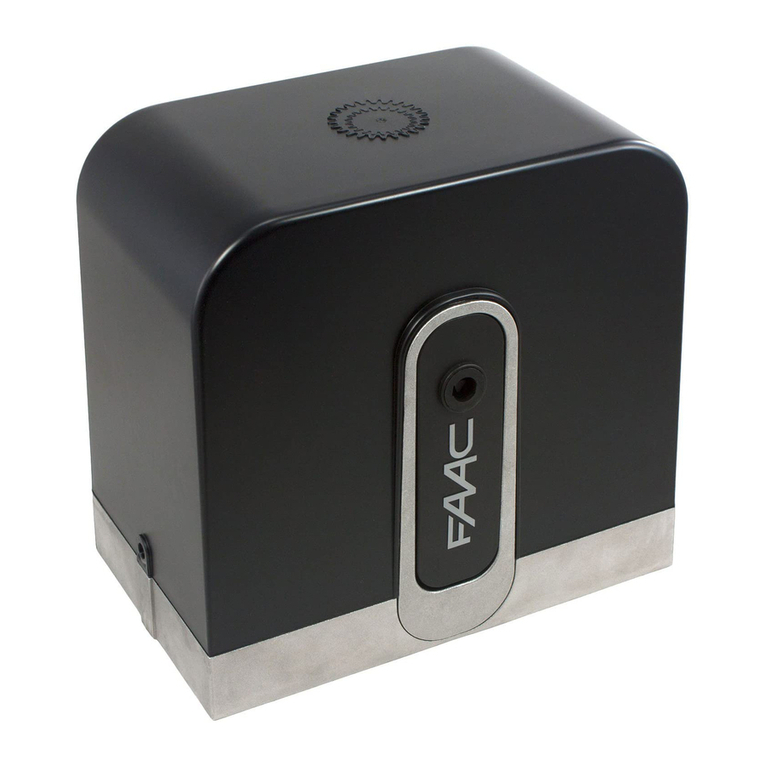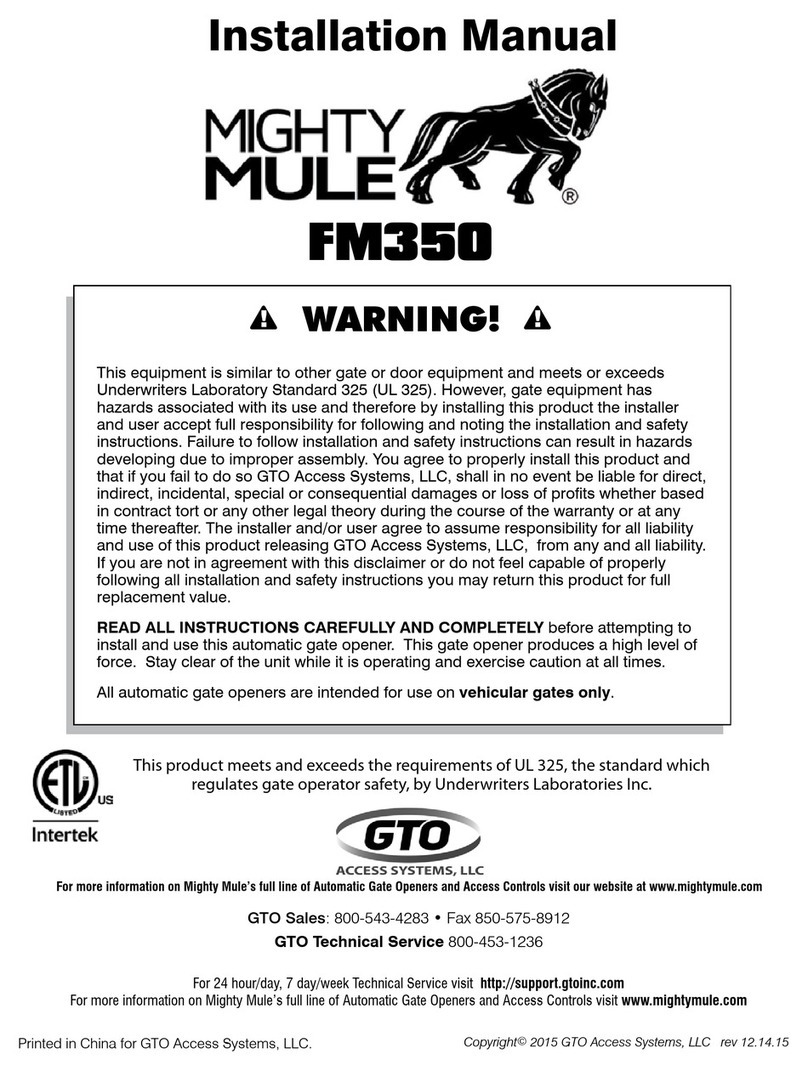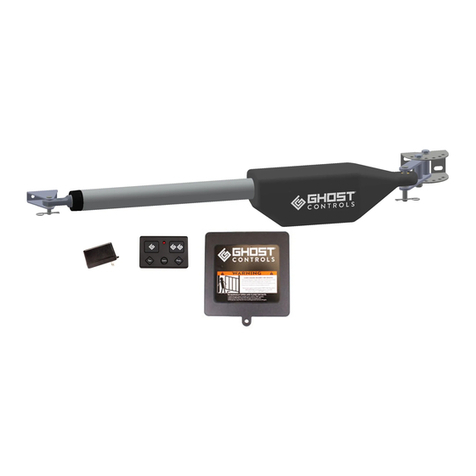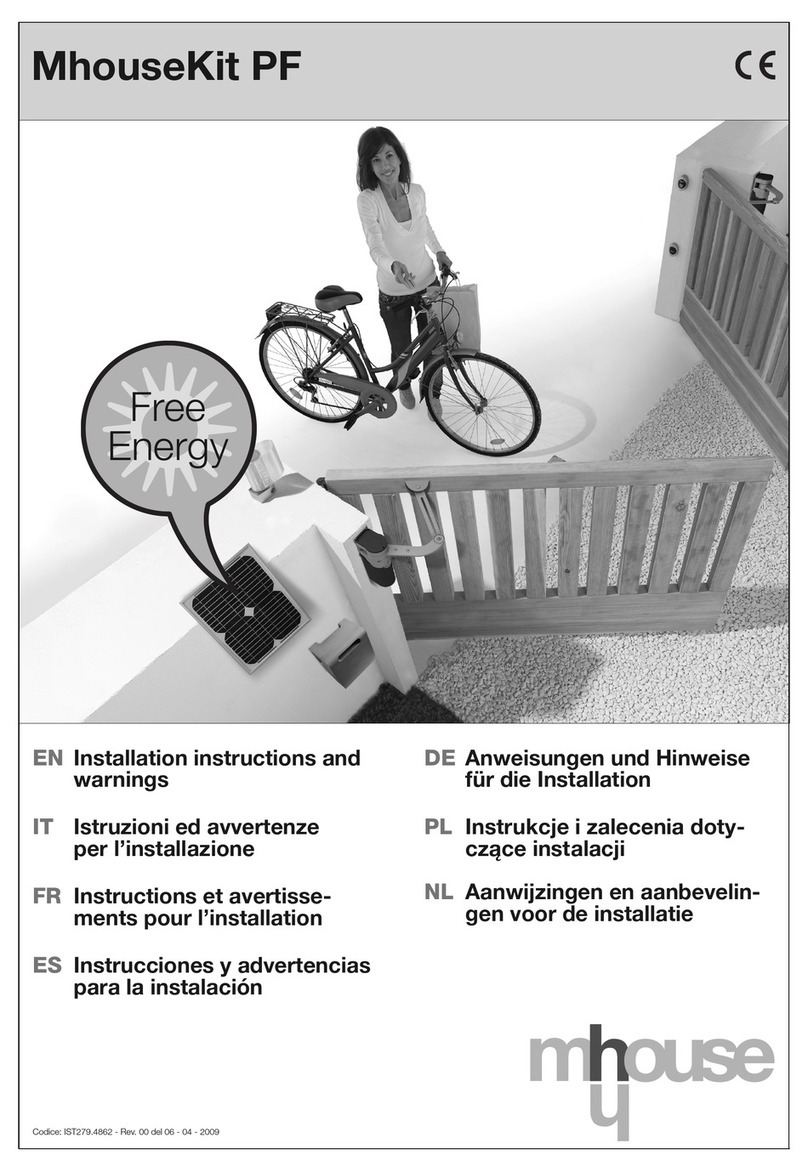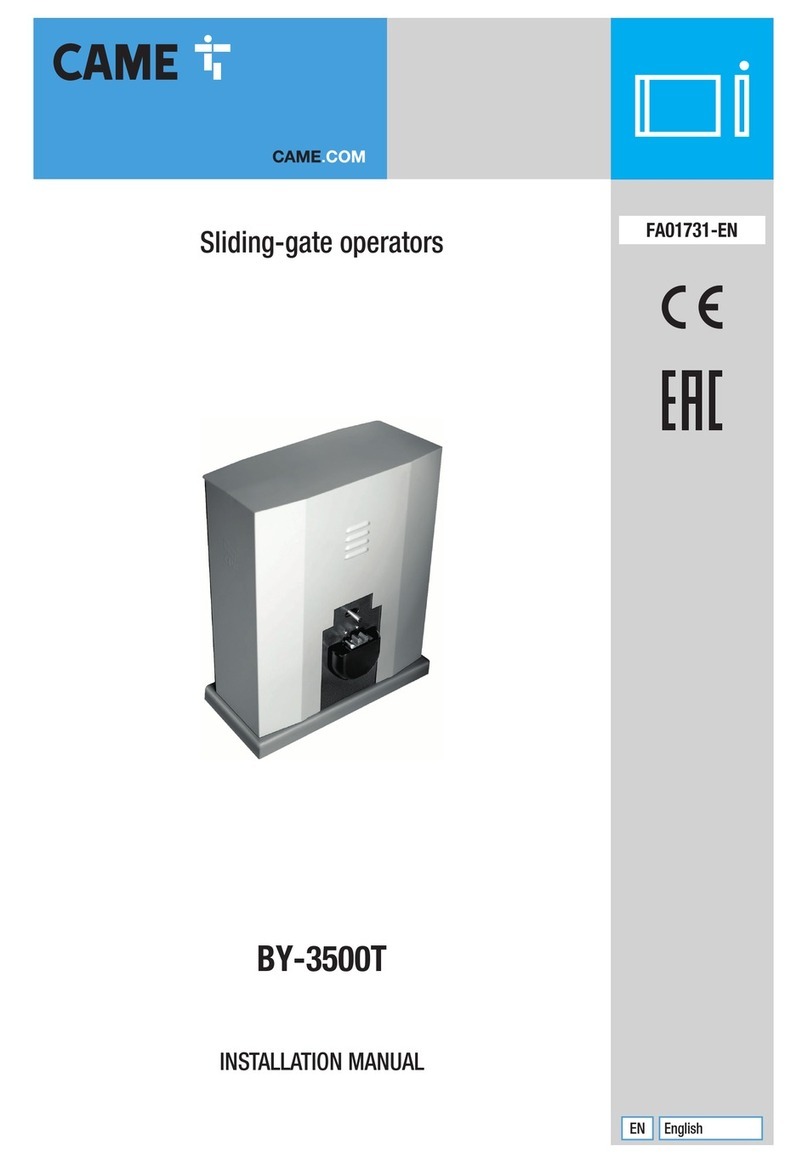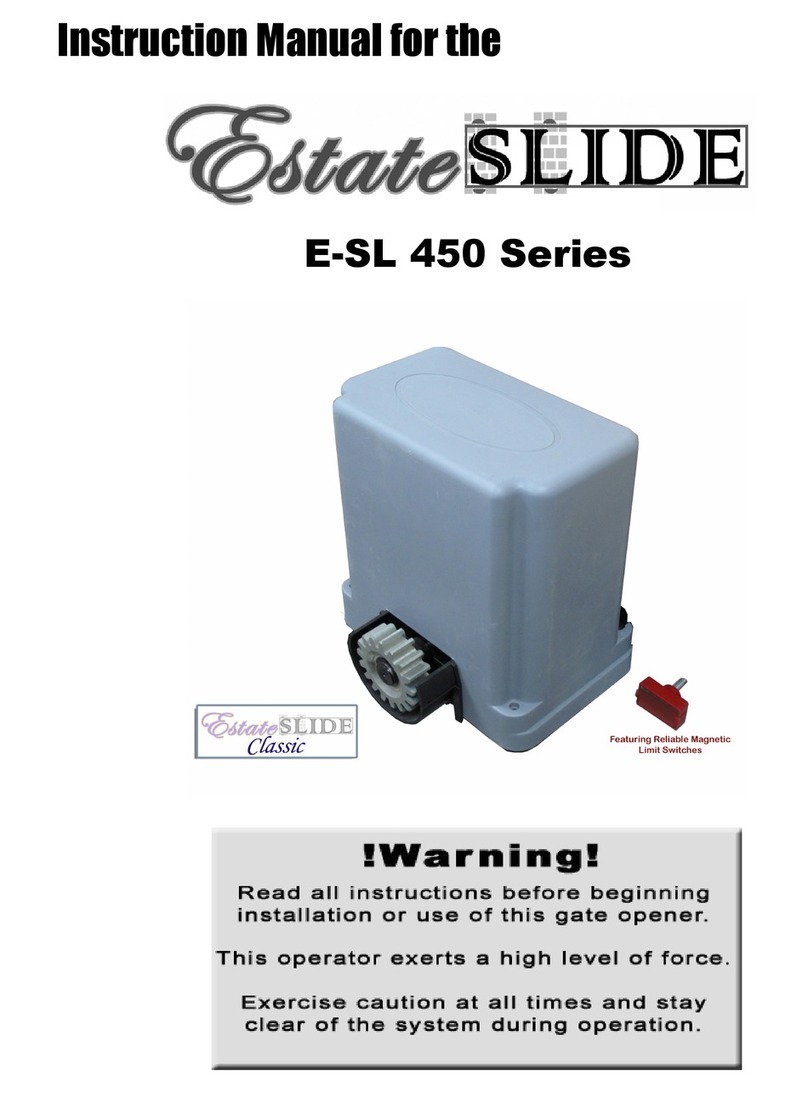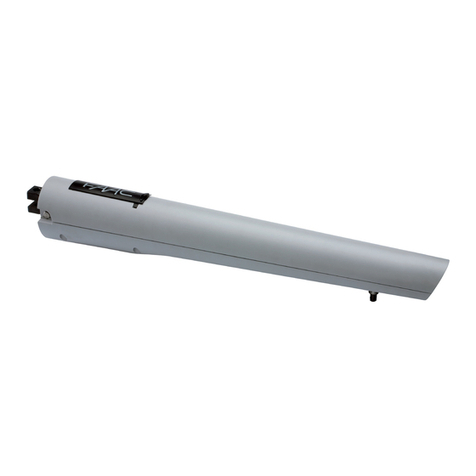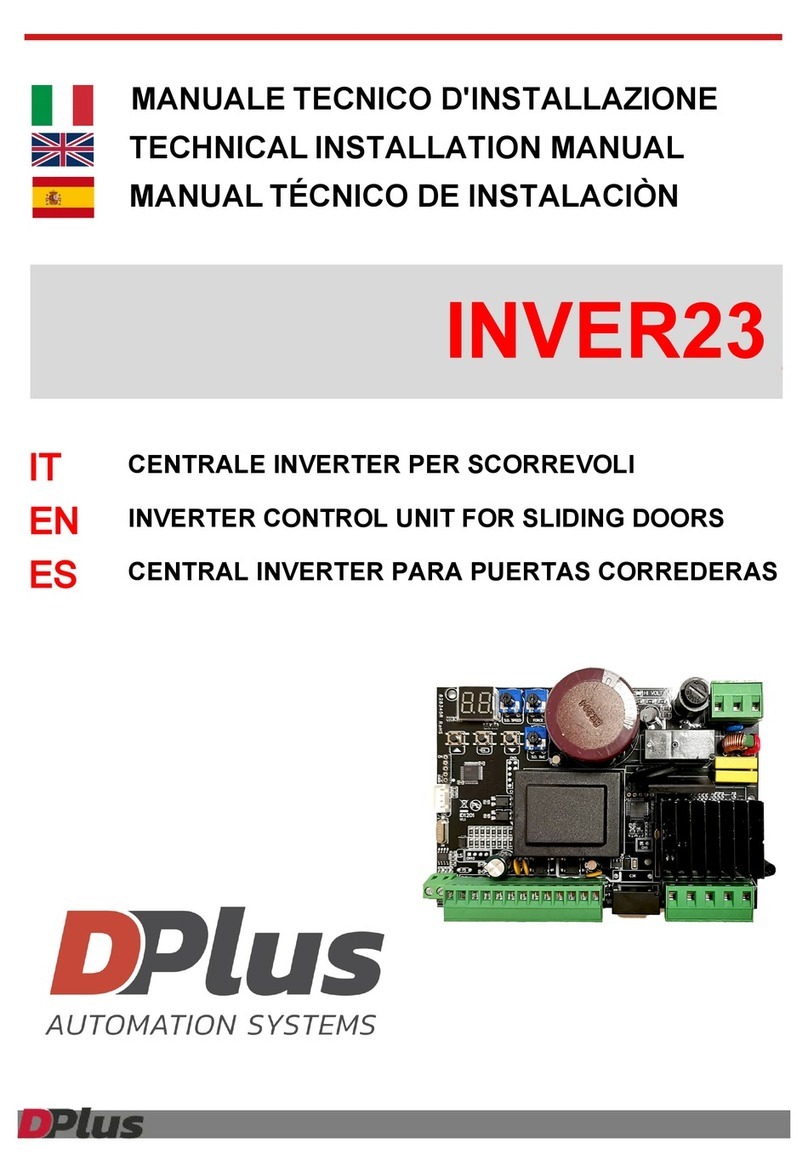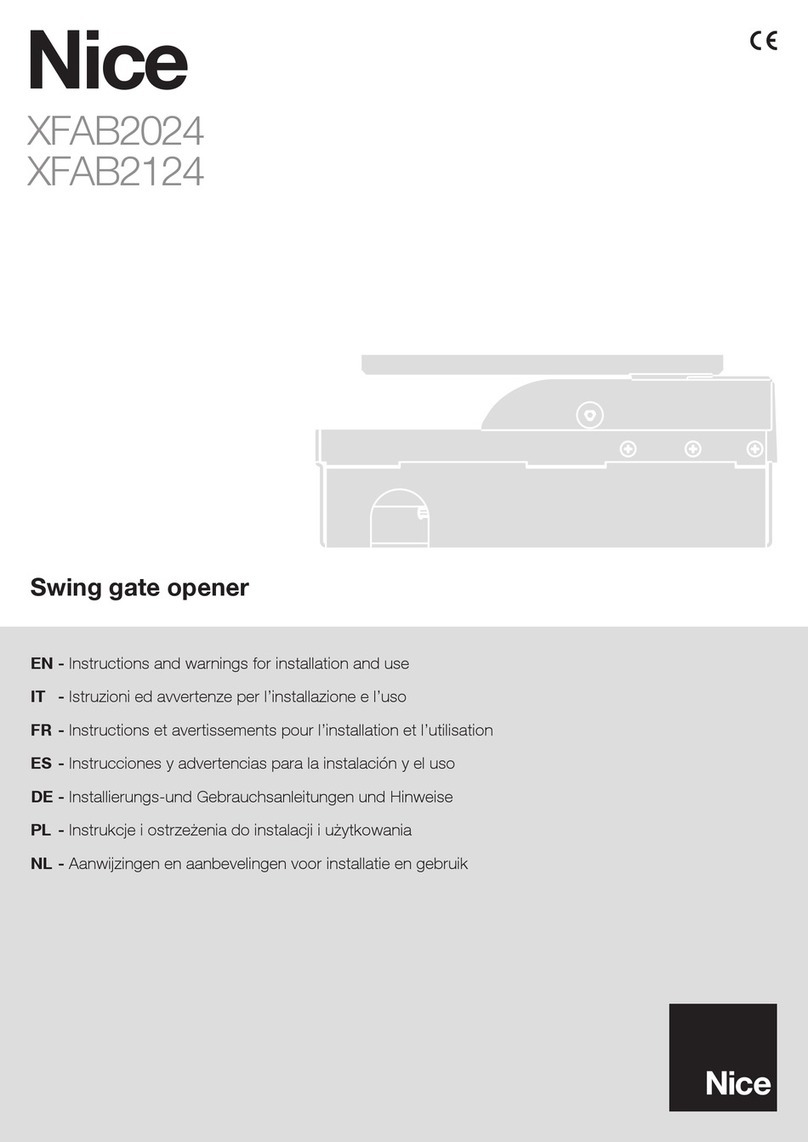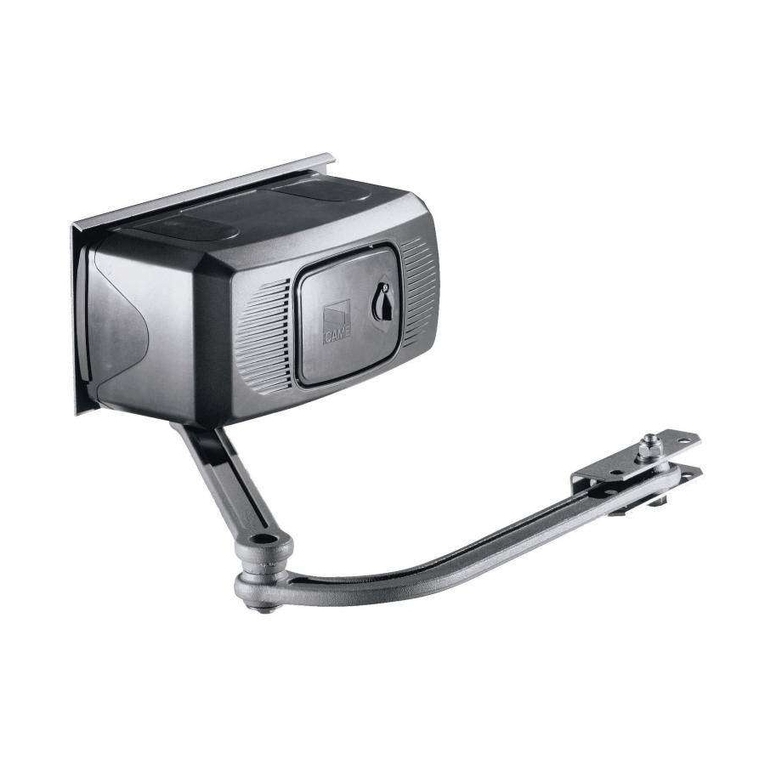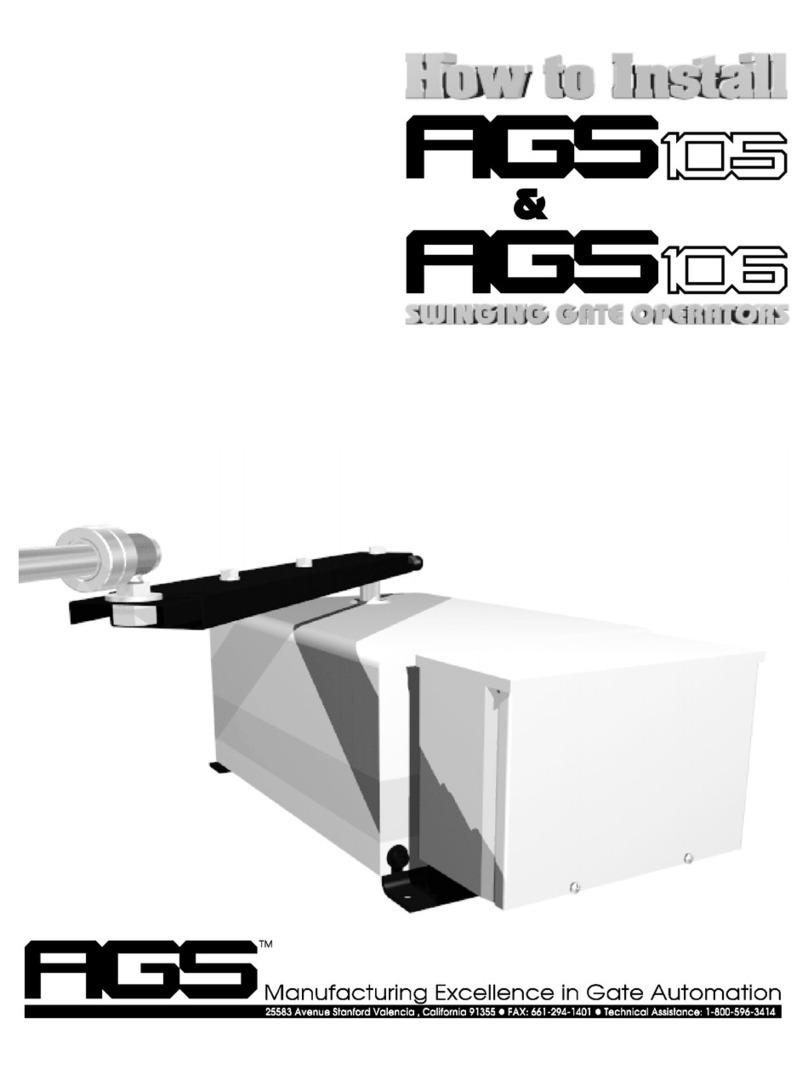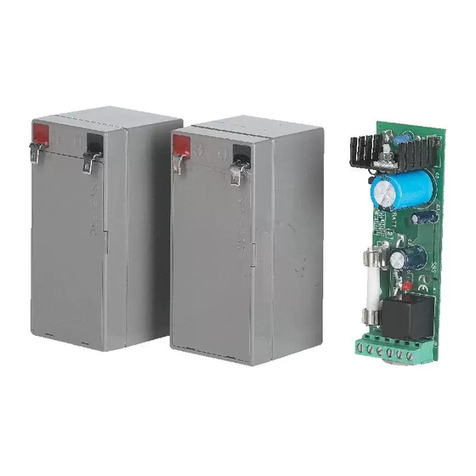AutoGate VPG-24 (LM) User manual

1.800.944.4283 AutoGate Technical Support JULY 2016
AutoGate, Inc.
7306 Driver Road
P.O. Box 50
Berlin Heights, OH 44814
PH: 1.800.944.4283
FAX: 419.588.3514
www.AutoGate.com
Installaon & Operaon Manual
Vercal Pivot Gate (VPG) System
VPG Operator-24 (LM)
Before aempng to install, operate or
maintain the operator, you MUST read and
fully understand this manual and follow all
safety instrucons.
This product is to be installed and serviced
by a trained Gate Systems Technician only.
Contact AutoGate for a local professional in
your area.

1.800.944.4283 AutoGate Technical Support JULY 2016
2
Safety & Helpful Informaon
AutoGate and the industry has endorsed three voluntary safety standards related to automatically operated
gate systems. In the United States, UL 325 addresses the manufacturing and installation of gate openers
and in Canada the standard is CSA 22.2 no. 247-14. ASTM F2200 addresses the design and construction
of gates for vehicular traffic that are to be automated.
UL 325: Standard for Door, Drapery, Gate, Louver, and Window Operators and Systems. For obtaining a
copy of this standard call Underwriters Laboratory at 1-888-853-3503 or order online at www.comm-
2000.com
CAN/CSA 22.2 no. 247-14: Standard for Operators and systems of Doors, Gates, Draperies and Louvres.
For obtaining a copy of this standard call CSA at 1-800-463-6727, email at sales@csagroup.org, or order
online at www.http://shop.csa.ca/
ASTM F2200: Standard Specification for Automated Vehicular Gate Construction. For obtaining a copy of
www.ASTM.org/.
Automatic vehicular gate operating systems provide convenience and security to the end user. A gate
operator is capable of producing high levels of force to move and or reverse gates. If a system is not
properly specified, installed, used, and maintained, serious injuries or death can result to someone in the
vicinity of a moving gate. Some situations that can lead to a possibility of serious injuries or death include:
absence of separate pedestrian access (automatic gates are for vehicular traffic only)
reaching through a gate to operate the system
attempting to climb under, over, or through a gate or the area covered by the travel of the gate
children playing on, or in the vicinity of, the gate
Improperly installed or physical failure of gate supporting hardware, which may allow a gate to “over
travel” or fall down or fall from its prescribed mounting position
unsafe gate designs and/or an absence of required entrapment protection devices
unsafe installations in which access control devices or pedestrian access areas have been located
within reach of or contacted by any part at any time by the moving gate
modifying a manufacturers design or components and failing to follow instructions
untrained individuals attempting to adjust, repair, or perform maintenance on a gate system
General Requirements from these standards (include, but are not limited to the following;)
1. Gates shall have smooth bottom edges, with vertical bottom edged protrusions not exceeding 1/2” (0.50
in. /12.7 mm) other than the exceptions listed in ASTM F2200.
2. The minimum height for barbed tape shall not be less than eight foot (8’) (2.44 m) above grade.
3. The minimum height for barbed wire shall not be less than six foot (6’) (1.83 m) above grade.
4. Protrusions shall not be permitted on any gate. Refer to ASTM F2200 for exceptions

1.800.944.4283 AutoGate Technical Support JULY 2016
3
General Requirements from these standards (continued)
5. Gates shall be designed, constructed and installed such that their movement shall not be initiated by
gravity when an automatic operator is disconnected from it’s supporting or drive system hardware. A
vehicular vertical pivot gate shall be restrained from movement along the arc of its path of travel.
6. The following provisions shall apply to Class I, Class II, and Class III vehicular vertical pivot gates:
All areas of the moving gate panel from the bottom of the gate to the top of the gate or a minimum of 72 in.
(1.83 m) above grade, whichever is less, that pass by a fixed stationary object, and in the area of the
adjacent fence that the gate covers during the travel of the gate, shall be designed, guarded or screened to
prevent a 2 1⁄4 in. (57 mm) diameter sphere from passing through such areas. A gap, measured in the
horizontal plane parallel to the roadway, between a fixed stationary object nearest the roadway (such as a
gate support post) and the gate frame when the gate is in either the fully open position or the fully closed
position on vertical pivot installations, shall not exceed four (4) inches (102 mm). Exception: All other fixed
stationary objects greater than 16 inches (406 mm) from the gate frame shall not be required to comply with
this section. Horizontal and vertical framing members of a gate shall be smooth, and shall not include
protrusions other than gate hardware to a maximum of 1/2” (0.50 in. /12.7 mm). All gates shall be designed
with sufficient lateral stability to assure that the gate will enter a receiver guide.
7. Class IV vehicular vertical pivot gates shall be designed, constructed and installed in accordance with
security related parameters specific to the application in question.
8. Controls intended for user activation must be located at least six feet (6’) away from any moving part of
the gate and where the user is prevented from reaching over, under, around or through the gate to operate
the controls. Exception: Emergency access controls only accessible by authorized personnel (e.g. fire, police,
EMS) may be placed at any location in the line-of-sight of the gate.
9. A minimum of four (4) WARNING SIGNS shall be installed, two on each side of the gate where easily
visible when the gate is open or closed.
10. A vehicular gate operator or vehicular drop arm operator shall have provisions for, or be supplied with, at
least two (2) independent monitored entrapment protection means as specified in UL 325 Table 31.1 for
each entrapment zone. At installation, both entrapment protection devices must be installed.
Vertical Pivot Gate Systems
Operator Entrapment Protection Types
Type A Inherent entrapment protection system (built into the control board)
Type B1 Non-contact sensors such as photoelectric sensor (Photo Beam)
Type B2 Contact sensors such as edge sensors
Note – The same type of device shall not be utilized for both entrapment protection means. Use of a
single device to cover both the opening and closing directions is in accordance with the requirement;
however, a single device is not required to cover both directions. A combination of one Type B1 for one
direction and one Type B2 for the other direction is the equivalent of one device for the purpose of
complying with the requirements of either entrapment protection means. This operator is provided with
Type A built into the control board. The installer is required to install additional entrapment protection
devices in each entrapment zone.

1.800.944.4283 AutoGate Technical Support JULY 2016
4
END USER / INSTALLER CHECK OFF LIST
IT IS RECOMMENDED THAT EACH ITEM ON THIS INSTALLATION CHECKOFF LIST
BE DISCUSSED WITH THE END USER.
____ FOUR WARNING SIGNS SECURELY INSTALLED, TWO ON EACH SIDE OF GATE VISABLE IN BOTH OPEN AND
CLOSED POSTION. (REQUIRED)
____ TWO MEANS OF ENTRAPMENT PROTECTION ARE INSTALLED TO REVERSE THE GATE IN THE CLOSING DIRECTION
(i.e. PHOTO BEAM, CONTACT SENSOR OR TYPE A CURRENT SENSING PER UL 325—6TH EDITION (REQUIRED)
____ OTHER ENTRAPMENT RISKS IN THE GATE TRAVEL AREA HAVE BEEN PROTECTED PER ASTM F-2200
(i.e. SCREENING, FENCING, ETC.) ( REQUIRED)
____ CUSTOMER ADVISED THAT GATE IS FOR VEHICULAR TRAFFIC ONLY. (REQUIRED)
____ A SEPARATE PEDESTRIAN ENTRY AND/OR EXIT IS PROVIDED. (REQUIRED)
____ GATE GUARD/FENCED OFF AREA INSTALLED ON BACK SIDE OF OPERATOR. (REQUIRED)
____ KICK PLATE INSTALLED ON DOOR SIDE OF OPERATOR. (REQUIRED)
____ ALL ACCESS CONTROL DEVICES A MINIMUM OF SIX FOOT (6’) AWAY FROM THE MOVING GATE PANEL. (REQUIRED)
____ CLASS OF OPERATOR IS APPROVED FOR THE APPLICATION OF THE OPERATOR (CLASS 1,2,3,4) (REQUIRED)
____ CONTROLS INTENDED TO RESET GATE AFTER BEING OBSTRUCTED ARE INSTALLED IN LINE OF SIGHT (REQUIRED)
____ FIELD WIRING SECURED TO AVOID PINCHING DAMAGE.
____ CUSTOMER INSTRUCTED AND IS CLEAR ON PROPER USE OF GATE OPERATOR. (REQUIRED)
____ CUSTOMER INSTRUCTED ON PROPER USE OF ALL CONTROL DEVICES USED WITH OPERATOR.
____ SAFETY INSTRUCTIONS WERE REVIEWED AND LEFT WITH CUSTOMER. (REQUIRED)
____ DISCUSS THE POTENTIAL FOR A PREVENTATIVE SERVICE AND MAINTENANCE CONTRACT.
____ A PHOTO OF COMPLETED INSTALLATION TAKEN FROM FRONT AND BACK OF GATE & DATED.
____ CUSTOMER TRAINED ON MANUAL OPERATION OF THE GATE.
____ CUSTOMER ADVISED NOT TO DISCONNECT THE UL 325 ENTRAPMENT ALARM IN ANY WAY
____ ALL ENTRAPMENT PROTECTION MEANS HAVE BEEN TESTED AND VERIFIED FOR PROPER OPERATION
THIS GATE OPERATOR IS INSTALLED FOR USE AS A CLASS ______ INSTALLATION.
Operator Class Designation
CLASS I - RESIDENTIAL VEHICULAR GATE OPERATOR – A vehicular gate operator (or system) intended for use in garages or
parking areas associated with a residence of one to four single families.
CLASS II – COMMERCIAL/GENERAL ACCESS VEHICULAR GATE OPERATOR – A vehicular gate operator (or system) intended for
use in a commercial location or building such as a multi-family housing unit (five or more single family units), hotel, garages, retail store
or other buildings accessible by or servicing the general public.
CLASS III – INDUSTRIAL/LIMITED ACCESS VEHICULAR GATE OPERATOR – A vehicular gate operator (or system) intended for use
in an industrial location or building such as a factory or loading dock area or other locations not accessible by or intended to service the
general public.
CLASS IV - RESTRICTED ACCESS VEHICULAR GATE OPERATOR – A vehicular gate operator (or system) intended for use in a
guarded industrial location or building such as an airport security area or other restricted access locations not servicing the general
public, in which unauthorized access is prevented via supervision by security personnel.
IT IS RECOMMENDED THAT END USER & INSTALLER
MUST RETAIN A COPY OF THIS CHECK OFF LIST FOR THEIR RECORDS

1.800.944.4283 AutoGate Technical Support JULY 2016
5
Table of Contents
Safety Information 2-3
Check Off List for Installer and End User 4
Table of Contents 5
Warning Instructions 6
Safety Instructions for Primary & Secondary Entrapment Protection 7
Recommended Secondary Entrapment Devices 7
Safety Instructions for Installers & Owners 8
Orientation 9-11
Preparations Prior to Installation 12-14
Installation 15-17
DC & AC Power Connecting, Operator Testing 18-21
Accessory Components 22-23
Troubleshooting & Checking Control Board 24-25
Electrical Quick Check Guide 26
Control Board Layout 27
Maintenance 28-30
Drawings 31-42

1.800.944.4283 AutoGate Technical Support JULY 2016
6
WARNING!
TO REDUCE THE RISK OF INJURY OR DEATH, READ AND FOLLOW ALL INSTRUCTIONS!
REDUCE RISK
1. Follow the safety standards of the Occupational Safety and Health Administration (OSHA), as well as any
applicable Federal, State, Local Project Specification and Industry Standards or Procedures.
2. Only experienced personnel are to install, operate and maintain the equipment. Serious injury or
equipment damage can occur if installed or operated by untrained personnel. Operators of the equipment
must follow the specific instructions and safety precautions located in this manual.
3. At NO time should the Gate Panel/Drop Arm be modified in any way.
4. Do not add any additional weight to the Gate Panel/Drop Arm without contacting AutoGate first. This can
affect the balancing and operation of the system.
5. Always keep people and objects away from all moving parts and entrapment/pinch points of the system.
NO PERSON OR OBJECT SHOULD CROSS THE PATH OF THE MOVING GATE.
6. Test the gate operator monthly. The gate MUST reverse on contact with a rigid object or stop when an
object activates the non-contact sensors or contact sensor. Sensitivity is adjusted at the “OC” or “CC” pro-
gramming function. Failure to adjust and reset the gate operator properly can increase the risk of injury
or death.
7. Use the belt tension lever release only when the gate panel/drop arm is not moving and powdered down.
8. Install the vehicular gate operator only when the operator is appropriate for the construction of the gate
panel/drop arm and the usage class of the gate.
9. The system is intended for only gates used for vehicles. Pedestrians MUST be supplied with a sepa-
rate access opening. The pedestrian access opening shall be designed to promote pedestrian usage.
Locate the gate panel/drop arm such that persons will not come in contact with the vehicular gate panel/
drop arm during the entire path of travel of the vehicular gate panel/drop arm.
10. The gate must be installed in a location so that enough clearance is maintained between the gate and
adjacent structures when opening and closing to reduce the risk of entrapment.
11. Check the are area where the gate will be installed and operated for overhead wires, limbs, buildings,
signs or any other fixed objects that may interfere with the gate travel.
12. Controls intended for user activation must be located at least six feet (6’) away from any moving part of the
gate panel/drop arm and where the user is prevented from reaching over, under, around or through the
gate panel/drop arm to operate the controls.
SAVE THESE INSTRUCTIONS
Automatic Gate Operators can produce high levels of force, therefore, it is very important that all gate
operator system installers and designers are fully aware of potential hazards that exist with an incorrectly
installed or designed system. The internal safety capabilities of a gate operator system are not enough to
reduce the risk of injury. The operator is only one part of a properly installed system which when combined
with all ASTM F2200 requirements and correctly installed approved entrapment devices will yield a
completed UL 325, 6th ed. and CSA 22.2 NO. 247-14 listed system that will not only provide convenience and
security, but will be safer with a minimal risk of injury. The following information contained in this manual
along with the installation checklist provided will make you aware of potential areas that are of a safety
concern. Disregarding any of the following may result in SERIOUS INJURY OR DEATH!

1.800.944.4283 AutoGate Technical Support JULY 2016
7
SAFETY INSTRUCTIONS REGARDING PRIMARY & SECONDARY
ENTRAPMENT PROTECTION
This unit is equipped with one (1) INTERNAL means of entrapment protection. (SEE UL 325 SECTION 30A)
Gate Operator shall provide one (1) INTERNAL (INHERENT) AND one (1) EXTERNAL entrapment feature.
INTERNAL:
(TYPE A) – Inherent entrapment sensing systems – operator will reverse direction when the inherent TYPE A
device senses an obstruction.
EXTERNAL:
(TYPE B1) – Provision for connection of a non-contact sensor (Photoelectric or equivalent)
(TYPE B2)— Provision for connection of a contact sensor (Edge devise or equivalent).
NOTE: Unit ships with S1-6 ON & S1-8 OFF. DO NOT change these settings (see page 12 for illustration).
PRIMARY PROTECTION- TYPE A INHERENT PROTECTION:
The unit will reverse direction when an obstruction is sensed while moving either direction. Sensitivity is
adjusted at the IRD1 on the control board while closing. If an obstruction is sensed by the primary inherent
sensor, the gate will reverse and open to the full open position. The gate will remain open until a close
command is received or will close by timer (if activated) after a new input is received. In order for the gate to
close by timer, a new input on the terminals J5-1-8 must be given. If an input is still present when the gate HAS
reached the full open position, this input will need to be renewed or removed and another input given before
the close timer will close the gate.
ENTRAPMENT ALARM:
Will activate upon the primary inherent sensor sensing a second obstruction before reaching a limit switch.
Once activated, the gate will remain at rest and an alarm will sound. The alarm can only be cleared by an input
applied to J5#4. The wiring used to reset the operator MUST be in the line of sight and MUST be an
“INTENDED” reset. Access control devices of any kind that require an intended activation may be
used for this reset. Devices that will cause an incidental reset should not be used, these include;
vehicle detectors, probes, timers, motion sensors, photo beams. Turning off the DC battery power
AND turning off the AC power at the GFCI service outlet will also reset the control board.
WARNING!
FAILURE TO COMPLY WITH THIS REQUIREMENT MAY RESULT
IN SERIOUS INJURY OR DEATH
APPROVED SECONDARY ENTRAPMENT DEVICES
PHOTO BEAMS
1)EMX INDUSTRIES MODEL#: IRB-325 TRANSMITTER / RECEIVER TYPE
2)ALLEN BRADLEY MODEL#: 60-2728 RETRO-REFLECTIVE TYPE
3)OMRON / MMTC MODEL#: E3K-R10K4-NR RETRO-REFLECTIVE TYPE
REVERSING EDGES (CONTACT EDGES)
MILLER EDGE MODEL— ME-120

1.800.944.4283 AutoGate Technical Support JULY 2016
8
WARNING!
TO REDUCE THE RISK OF INJURY OR DEATH, READ AND FOLLOW ALL INSTRUCTIONS!
SAFETY INSTRUCTIONS FOR INSTALLER AND END USER
Proper design is important in your system layout and installation. Entrapment devices must be used at all
available points where injury or property damage may occur. For protection from injury to persons, use
approved Entrapment devices across the driveway. Reversing Loops (Vehicle Detectors) should be installed
in front and behind the gate to provide a reverse signal or stop signal to the gate operator. All reversing
devices should be tested and inspected monthly. If a Reserving Loop or Loop detector malfunction, operator
should be disabled until repair can be made by an experienced service company.
In providing the service of “designer” or “installer” of the operator and gate system, you are responsible for
educating the END USER on proper and safe operation of the gate system. All precautions to eliminate
hazards MUST be taken before the system can be put into operation. All identified entrapment areas are
required to be protected against entrapment. Refer to ASTM F2200 for diagrams of common entrapment
areas.
Check the National, State & Local building and fire codes BEFORE installation
If you did not order a Reversing Edge (for along the bottom rail of your gate), or an Infra-Red Modulat-
ed Photocell (Reversing Beam), you will NOT be in compliance with March 2000 UL 325 Code, Rev 5.
Consult your dealer for additional information.
Pedestrians must use a separate entrance/exit and never the vehicular entrance/exit gate.
NEVER activate the gate from long distances where visibility of the gate cannot be seen. Anyone
operating the gate should always operate it in a safe manner.
NEVER allow children or anyone to play on or around the gate at any time.
DO NOT affix any adhesive material within 30 days of receiving the system.
DO NOT attach anything to the gate over four (4) pounds total weight or four (4) square feet without
consulting AutoGate for re-balancing instructions. The gate must remain balanced to ensure safe and
reliable operation.
The gate and operator are designed to work together. DO NOT attempt to install an unauthorized gate
without AutoGate’s prior authorization and instructions, doing so may VOID the operator warranty.
DO NOT ALLOW any access control devices to be mounted within 6 feet of the moving gate or in such a
way that someone could reach their hand or arm through the gate to activate it.
WARNING!
THE GATE OPERATOR IS DESIGNED AND FACTORY BALANCED FOR THE SPECIFIC GATE
IT WAS SUPPLIED WITH.
DO NOT MODIFY THE GATE IN ANY WAY OR ADD SIGNS WEIGHING MORE THAN 4 LBS TOTAL
OR FOUR (4’) SQUARE FT.
FAILURE TO COMPLY WITH THIS REQUIREMENT WILL VOID THE WARRANTY AND MAY RESULT
IN SERIOUS INJURY OR DEATH.

1.800.944.4283 AutoGate Technical Support JULY 2016
9
ORIENTATION
The AutoGate Vertical Pivot Gate (VPG) in this manual you will see it referred to as “system” .The VPG has
many features that make it effective, reliable, and easy to use, and some of these important features are
summarized in the table below. Note that not all systems are identical as width, gate panel implementation,
finish, accessories such as lights, and other accessory component options vary order to order. Below are
some key features to the System.
GLOSSARY & TERMS
Figure 1.1 through 1.3 will orient you to the basic components of the system. Most of the terms are self
explanatory; however, the following will help you understand certain components and terms.
Operator - A mechanical device used to open and close (raise and lower) a gate panel/drop arm system.
False Panel - Parallel to operator enclosure is the False Panel. It is permanently attached to the operator
and is comprised of two (2”) inch steel tubing and sheet metal. Its purpose is to protect pedestrian,
technician, and system users from being in the area of the pivoting gate panel/drop arm.
Hand (or handing) - The system comes in left hand or right hand configurations. This refers to the location
of the operator when viewed from the secured side of the closed Gate. To illustrate “handing” see the figure
1.1 for an example of a Right Handed (RH) system.
Feature Explanation
All Electric Operation.
NO HYDRAULICS!
24 volt DC with input voltage of 120-volt (standard) or 240-volt single phase.
Built-in battery backup for continued operation during power outages. Can be
outfitted with solar charging for remote locations without AC power. No hydraulic
fluids (for environmentally sensitive areas). Batteries are not included, but are
required.
Gate Panel Options Ranging from highly decorative pickets to a simple chain link or industrial anti-climb
panels for military or correctional facilities.
Opens Completely The VPG opens fully to 90°. Easily accommodates tall vehicles and equipment.
Duty Cycle: Continuous The operator is engineered and rated for continuous duty and is specifically
designed for constant use throughout the day.
Low Maintenance Requires only periodic lubrication and annual tension adjustment. Very low order
of service required compared to our competition.

1.800.944.4283 AutoGate Technical Support JULY 2016
10
Operator Orientation
All of the operators mechanical and electrical components are housed inside the operator (See Figure 1.2
through Figure 1.4). The operator is a lockable steel cabinet that mounts on a raised concrete pad. A
separate NEMA 4x electrical enclosure is also housed inside the operator. The electrical enclosure contains
the master control circuit board and the terminal blocks/wire management system. It may also house a variety
of optional electrical components and configuration custom to your specific order.
Figure 1.1 Operator (not depicting Drop Arm or optional gate panel)
Figure 1.2 Components Housed in the Operator (Picture may not depict exact items)
Operator Gate Arm
Operator Gate Arm
False Panel
Cabinet Doors
Throat—the area between the operator and the false panel.
AMP Meter &
Cycle Counter
NEMA 4x
Electrical
Enclosure
Battery Shelf
GFCI Service
Outlet
(120 VAC, 15A
Footpads Extension Springs
Transportation/Maintenance (T/M) safety
pin (shown in Drop Arm closed position)
Drive Pullies
(“Bullwheels” )
Electrical enclo-
sure is hiding the
2nd Bullwheel
Slide Assembly
Pivot Shaft
Linkage Arm
Drive Motor

1.800.944.4283 AutoGate Technical Support JULY 2016
11
Electrical Enclosure
The control board is configured to receive input commands from nearly any type of access control device
such as a card reader, keypad, push button panel, vehicular loop detector, over-speed detector, or even a
PLC. In short, the control board accepts dry contact inputs to provide the necessary open, close, or reversing
commands to the board. The control board also has a built in battery charging system to maintain proper
back-up battery voltage for hundreds of cycles in the event of a power outage.
The system can also be configured to operate: 1, 2 or 3 color traffic lights, audible alarm devices, external
emergency shut-off switch, output to an external source to indicate gate open/closed, and several other
configurations including LED warning lights on the Gate Panel/Drop Arm.
Pre-installed amp meter and cycle counters are a standard on all systems from AutoGate with the Liftmaster
Control Board..
AutoGate mounts the Liftmaster Control Board in a NEMA 4X Electrical enclosure box.
Figure 1.3 Electrical Enclosure (Inside)
Figure 1.4 Electrical Enclosure (Outside)
Loop Detector Sockets (Free Exit & Reversing)
Liftmaster
Control Board
Amp Meter
Cycle Counter
NEMA 4x
Enclosure
DC/Battery
Power Toggle Switch1 AMP MAX 24 VDC
Accessory Power Strip

1.800.944.4283 AutoGate Technical Support JULY 2016
12
PREPARATIONS PRIOR TO INSTALLATION
T/M (Transportation & Maintenance) Safety Pin Warning!
When you receive your system, it has a safety device called a T/M Safety Pin installed (see Figures 2.1-2.3
below). T/M stands for Transportation and Maintenance because the pin must be installed during shipping,
installation, and whenever maintenance is being performed. Do not remove this pin until the instructions in
this manual direct you to do so!
FIGURE 2.1 Figure 2.2
Figure 2.3
SITE PREPARATION & PLANNING
Inspect the site and verify there are no underground utilities, overhead wires, or other obstructions that can
affect your installation and use. Keep routine foot traffic away from the system to reduce the chance of
pedestrians or site personnel contact with a moving system. A separate pedestrian gate or turnstile is highly
recommended to discourage the use of the system by anything other than vehicular traffic.
Determine if there are any accessory components to be installed with your system and necessary conduit
used for traffic lights, in-ground loops, access control stations, etc. and factor them into your sire layout and
installation plan.
High voltage and control wiring must NOT be run in the same conduit.
Concrete Pads
Concrete pads are required to install the VP Operator & Yoke. Along with securing the operator to the entry /
exit point, the pad provides a fixed and adequate foundation to resist wind and maintain stability for many
years of operation. Prior to pouring the concrete for the operator pad ensure the soil is undisturbed or
compacted to local or governing standards. (See DWG. 102-P)
4’ X 7’ Operator Pad Options:
1. Full Pad, Minimum depth of 36" or below local frost line
2. 10"-12” thick pad with five (5) 12" dia. x 36" deep holes or below local frost line
Springs Are Under High Tension!—CAUTION!!
T/M Pin viewed from inside the operator
T/M Pin viewed in
the operator throat
Area (Door Keys are
attached here for
shipping)

1.800.944.4283 AutoGate Technical Support JULY 2016
13
Vehicle Loop Installation and Performance
Ground vehicle sensing loops are very common to gate sites. They are used for the detection of vehicles
which then triggers the gate to do a specific action. Proper installation and placement is critical. If you
purchased Pre-formed Loops carefully follow the enclosed installation instructions and use the diagram
below for the proper placement of the ground loops. If you are constructing the loops on-site, be certain to
use D.O.T. approved materials and methods.
Test the function of the loops thoroughly by using vehicles once installed to verify correct operation.
Figure 2.4

1.800.944.4283 AutoGate Technical Support JULY 2016
14
PREPARATIONS PRIOR TO INSTALLATION
RECOMMENDED TOOLS AND EQUIPMENT
Lifting Strap Multi-Meter (DCV & AMPS)
Hammer & Level Hammer Drill, 1/2 & 5/8 Bits
Grease Gun, Lithium Grease Tape Measure
Screwdriver Sets (Flat & Phillips) ½” Drive Socket Set: 1/2”, 9/16”, 3/4”, 15/16”, 1-1/8”
Electrical Tape Open End Wrenches: 1/2”, 9/16”, 3/4”, 15/16”, 1-5/16”
Wire Cutters/Strippers Misc. Electrical Connectors
Chalk Line Batteries (2) 12 VDC Group 24 Deep cycle marine
NOTE: Refer to manufacturer’s instructions of Accessory Equipment for correct wire size and type.
RECEIVING & UNLOADING INSTRUCTIONS
Unloading & Unpacking - Gate weight per foot varies with gate style & height and are approximate. Operator
weighs1150 lbs., steel gates are 24 lbs. per foot and aluminum gates weigh 19 lbs. per foot.
1. Have adequate equipment ready to unload your Gate and Operator safely. Utilize a Liftgate service when
available from the LTL carrier.
2. Before removing your Gate and Operator from the truck, inspect it for any visible damage and make sure
the Gate Box was shipped upright. (DO NOT DROP EITHER GATE OR OPERATOR BOX). Photograph
and retain if damaged as well.
3. After uncrating your Operator, locate and remove the door lock keys attached to the Transport/
Maintenance (T/M) Safety Pin. DO NOT REMOVE T/M PIN. ONLY REMOVE HAIR PIN RETAINER TO
REMOVE THE KEYS THEN REPLACE HAIRPIN. (See Figure 2.3)
4. Any transmitter, antenna, or other ordered accessories will be boxed inside your operator cabinet.
5. Unpack gate panel crating very carefully.

1.800.944.4283 AutoGate Technical Support JULY 2016
15
INSTALLATION
Installing VP Gate and Operator
1. Position Gate on Operator Arm.
2. Use (1) SS 3/4”-10 x 4 1/2” (STEEL GATE) or (1) SS 3/4”-10 x 5” (ALUMINUM GATE) Bolt for the top
connection. Use (4) SS 1/2 x 1-1/2" Bolts for the bottom connection.
3. Insert the top bolt first and then the bottom four (4) bolts finger tight. Be certain gate is properly aligned
before tightening. Tighten bottom bolts first, then tighten top bolt.
4. Locate washers and Linkage Pivot Bolt (5/8" x 2-1/4") and insert through rod end fitting and tighten bolt into
the gate lug hole as shown below. You may have to push down on the gate to insert Linkage Bolt.
Lifting Gate & Operator
To lift Gate & Operator use a lifting strap. The strap should be secured around Operator Arm and T/M Safety
Pin or the top rail of the gate near the operator arm. See Figure 3.2 & 3.3
Figure 3.2 Figure 3.3
NOTE: It is recommended to attach Gate to Operator Arm before lifting (for better balance), but it is not mandatory. If
using a Forklift to position Operator only, lift from sides only! Do not try to lift gate and operator together from the side
Positioning Gate Panel/Drop Arm & Operator
Refer to the site drawing for your specific order as there may be details unique to the installation.
1. Place Gate & Operator Assembly on pad so the end of the Gate is centered over the Yoke pad or intended
yoke position for the site (for yoke styles mounted to posts, buildings, etc.). Allow a minimum three (3")
inches from edge of pad to bolt holes to prevent concrete damage
2. Position and align Pad Yoke and center under gate.
3. Secure Operator with (1) 5/8" dia. Wedge Bolt in rear; check alignment on pad as well as gate panel/Drop
Arm alignment before installing remaining anchor bolts.
4. Install remaining four (4) 5 1/2” x 5/8" dia. Concrete Anchor Bolts provided, (level Gate Panel/Drop Arm
and Operator on pad, if necessary).
5. Secure Yoke with four (4) 1/2” dia. Anchor bolts (provided). If installing a Ground Yoke, allow a minimum
space of two (2") inches between bottom of Gate and Yoke.
Figure 3.1
Figure 3.1

1.800.944.4283 AutoGate Technical Support JULY 2016
16
Installing Other Components
Cable Wind Bracing
Masted Wind Bracing

1.800.944.4283 AutoGate Technical Support JULY 2016
17
KICK PANEL: Attach the Kick Panel to the door side
of the operator using the three (3) # 12 x 3/4 TEK
screws. See GREEN example kick Plate below.
Installing Other Components
GATE GUARD
NOTE: The area behind the operator is an entrapment zone.
The installer must prevent or protect pedestrian access to
this area by at least one or more of the following:
Install factory supplied Gate Guard
Site installed fencing
Utilize Recommended Entrapment Protection Devices
Entrapment Zones (RED shaded areas)
Fencing Gate in closed position Fencing
Fencing as an option
to restrict pedestrian
access in this area.
Opening Entrapment Zones
Gate in “OPEN” position below (shaded area)
requires installer to install one (1) of the fol-
lowing: Fencing, installation of provided gate
guard, or entrapment protection devices.
Closing Entrapment Zone
Below illustrates the minimum known entrapment zone
when gate is closing. Installation of an approved B1
non-contact sensor (Photo Beam) is shown in blue
including beam path. Additionally, installation of an
approved B2 contact sensor is shown in bright green.
WARNING!
THIS PAGE ILLISTRATES THE MINIMUM KNOWN
ENTRAPMENT ZONES. ANY OTHER ENTRAPMENT
ZONES MUST BE MITIGATED BY THE INSTALLER
IN ACCORDANCE WITH UL 325 & ASTM F2200 TO
REDUCE THE RISK OF PROPERTY DAMAGE, INJURY
OR DEATH. THE INSTALLER MUST REDUCE PUBLIC
EXPOSURE TO POTENTIAL HAZARDS.

1.800.944.4283 AutoGate Technical Support JULY 2016
18
Initial Power Connection & Operator Testing
1. Connecting Batteries - Required
A. Install two (2) 12 VDC Batteries (not provided) on the battery shelf. AutoGate recommends Group 24,
100 Amp hour deep cycle marine batteries for extended battery back up. At a minimum use seven (7) AH
batteries for battery back up. See drawing below for proper battery and jumper hook up. BATTERIES
MUST REST IN A LEVEL POSTION ON THE BATTERY TRAY TO AVOID ACID LEAKING FROM
BATTERIES.
B. Install Jumper Wire (provided) from Battery #1 - POSITIVE to Battery #2 - NEGATIVE (See Below).
C. Locate RED and BLACK Power Wires and connect:
NOTE: Battery back up duration will depend on the size of batteries, number of accessories and open/close
cycles while being powered by the batteries.
2. Temporarily remove any wires in the main circuit board J5 Strip, Terminal #5 (rev./safety) to disable any
Reversing devices not installed from preventing the gate from closing.
3. With all personnel clear of any moving part or component of the system you will take the next steps to
cycle the gate up and down a few times to verify proper operation. Turn Main DC Power Switch “on”.
(Located under the Electrical Enclosure) Use the S3 manual open/close switch on the control board.
4. Verify basic operator system function
NOTE: The gate should activate and open in approximately 10-12 seconds. In DC only operation the
cycle time could vary. If your gate does not lift properly, refer to "Troubleshooting Tips" pages 22—23.
12 VDC Battery
12 VDC Battery
Black Lead
Red Lead
BLACK TO BATT. #1 - NEGATIVE
RED TO BATT. #2 - POSITIVE
CAUTION: At this point you have no external safety devices
connected to your operator. Open with care!!
!
Use the MANUAL Open-Close
switch to test your operator.
Jumper

1.800.944.4283 AutoGate Technical Support JULY 2016
19
AC POWER CONNECTION
Connecting AC Power
1. Turn Off DC power.
2. Wire incoming AC power to the 4 x 4 Box provided and turn on the breaker from your AC Source.
3. Turn AC Power Switch on at the 4 x 4 Box.
NOTE: The A/C Power must be connected by a qualified, licensed Electrician, according to the National Electric
Code, and all State and Local codes. Refer to electrical block diagram for additional information.
WARNING!
TO REDUCE THE RISK OF ELECTRICAL SHOCK, THIS EQUIPMENT HAS A GFCI TYPE PLUG
THAT HAS A THIRD (GROUNDING) PIN. THIS PLUG WILL ONLY FIT INTO A GROUNDING TYPE
OUTLET. IF THE PLUG DOES NOT FIT IN THE OUTLET, CONTACT A QUALIFIED ELECTRICIAN
TO INSTALL THE PROPER OUTLET. DO NOT CHANGE THE PLUG IN ANY WAY.
Operator Main AC Power Switch
(pre-wired to outlet)
120 AC (Black) (BRASS terminal)
Neutral (White) (SILVER terminal)
Green (Ground)
ON
A/C ELECTRICAL SUPPLY
MINIMAL REQUIREMENTS:
120 VAC, 15AMP CIRCUIT
FOR CLASS 1 APPLICATIONS YOU
MAY NOT EXCEED 15 AMPS
WARNING!
ADDITIONAL 120 VAC SURGE PROTECTION IS RECOMMENDED BUT NOT REQUIRED.
SURGE UNIT MUST BE GROUNDED TO A TRUE EARTH GROUND.
AC OUTLETS ARE HOT AT ALL TIMES. OUTLETS ARE FOR SERVICE USE ONLY.
OPERATOR MUST BE GROUNDED TO TRUE EARTH GROUND LUG LOCATED ON FRAME
Pre-Mounted 120 VAC Electrical Outlet & AC Power Switch Electrical Connection

1.800.944.4283 AutoGate Technical Support JULY 2016
20
CONTROL BOARD
The VP gate has many features and options. Most are controlled by an electronic circuit board inside the
Control Box. The circuit board is factory set and should not be altered in any way or the Warranty may be
voided. If an adjustment has to be made, consult your Control Board Instructions for details. If you need any
further assistance, please contact your local AutoGate Dealer or call AutoGate at 1-800-944-4283.
Timers and Mode Selections (S1) SEE DIAGRAM BELOW
Full Speed Run Timer – Switch Pack S1 (1-5) Switches one (1) through five (5) are FACTORY PRESET.
DO NOT CHANGE!
Mode Selections – Switch Pack S1 (6-8). SEE DIAGRAM ABOVE
SWITCH 6 – “On”. This is set for the UL 325 Alarm. (DO NOT CHANGE!).
SWITCH 7 - FACTORY PRESET. (DO NOT CHANGE!).
SWITCH 8 – “Off” Not used on this system.
S2
Timers & Mode Selections – Switch Pack S2 (1-8). SEE DIAGRAM ABOVE
SWITCHES 1-5 on S2 are for the closing timer delay. Default is S2-3 “ON” to provide a eight (8) second delay
if activated. If S2-7 is on, the gate will auto close by timer.
SWITCH 6 – Sets auxiliary. Open input terminal #4 at J5 to be pulse open-pulse close (Default is On).
SWITCH 7 – AUTO CLOSE TIMER – Default is ON. When on, use S2 1-5 to set close time delay. When
close timer is selected, you MUST install vehicle and pedestrian detection devices.
SWITCH 8 – AUTO OPEN ON POWER FAILURE – When switch eight (8) is in the ON position, the operator
will automatically open the gate approximately 15 seconds after the loss of power. Once
power is restored, the operator will resume normal operation. Factory setting is “OFF” allowing
the operator to function normally until the battery power has diminished. Once A/C has been
restored, the operator will function normally.
NOTE: If batteries were completely discharged, remove from operator and recharge with a commercial grade
battery charger.
1-5 Fast Run Timer 6-8 Mode Selection
1 2 4 8 16 (Seconds)
1 2 3 4 5 6 7 8
ON
OFF
S1
2 4 8 16 32 (Seconds)
1 2 3 4 5 6 7 8
1-5 Closing Time Delay 6-8 Read Below
ON
OFF
Table of contents
Other AutoGate Gate Opener manuals
